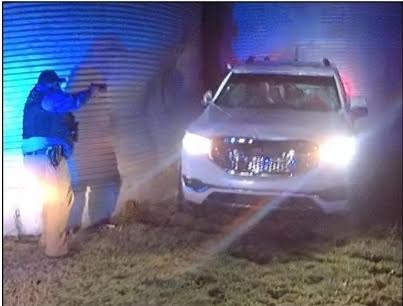Book review: ‘The Second’
Published 12:00 am Sunday, March 13, 2022

- BOOK REVIEW
“The Second: Race and Guns in a Fatally Unequal America” by Carol Anderson. New York: Bloomsbury Publishing, 2021. 272 pages, $28 (hardcover).
“To be clear, this is not a pro-gun or anti-gun book,” Carol Anderson explains near the beginning of “The Second: Race and Guns in a Fatally Unequal America,” her ground-breaking attempt to reframe the still-evolving narrative on how we should view the resurgence of gun violence in this country that currently plagues a higher proportion of individuals of color. “Guns are not the key variable here. It’s Black people. Their legal status – enslaved, free Black, denizen, Jim Crowed citizen or citizen of ‘post-racial America’ – did not change the way the Second Amendment worked against their rights.
Trending
“From colonial times through the 21st century, regardless of the laws, regardless of court decisions, regardless of the changing political environment, the Second has consistently meant this: The second a Black person exercises that right, the second they pick up a gun to protect themselves (or not), their life – as surely as Philando Castile’s, as surely as Alton Sterling’s, as surely as 12-year-old Tamir Rice’s – could be snatched away in that same fatal second,” she continues. “Once all the distracting arguments about individual versus collective gun rights are stripped away, it becomes clear that this debate is quite simply dwarfed by a much broader national discussion about rights and equality. The NRA’s (National Rifle Association) insistence on framing the ‘Second Amendment: A Citizen’s Right’ has dominated the argument, with the only question being a citizen’s right to do what?”
So begins a fascinating and enlightening discussion of one of the most divisive issues in contemporary society. It is important to note up front, however, that the author does not take sides in the ongoing dialog about the efficacy of the Second Amendment in a traditional sense (as explained in the preceding excerpt); i.e., her aim is not to come down on one side or the other regarding the right to bear arms. In a very real sense, the purpose of this book is really to force the reader to re-conceptualize the reasons behind why the legislation was given such a prominent place in the legal pantheon that forms the basic architecture of our 200-year experiment is self-governance. And on that front, I can report she succeeds spectacularly. Of course, you have to have an open mind and moderately-developed critical thinking skills to see what she labors to convey on virtually every page, but my sense is that most readers have the requisite aptitudes (if not the inclination) to exhibit both.
The book is one of the more extensively researched I have had occasion to read in quite some time, with 70 pages of source notes at the conclusion of the introduction, four chapters and epilogue that form the main text. Unlike the multitude of other volumes that have dissected this issue over the last few years, even the chapter titles are particularly intriguing and inherently revealing: The Introduction, “Why Did You Shoot Him, Sir?,” Chapter One, “Sheep Will Never Make a Revolution,” Chapter Two, “Keeping a Ferocious Monster in Chains,” Chapter Three, “The Right to Kill Negroes,” Chapter Four, “How Can I Be Unarmed When My Blackness Is the Weapon That You Fear,” and the Epilogue, “Racism Lies Around like a Loaded Weapon.”
Anderson’s literary style is conversational and convincing; she is meticulous and detailed in laying out her case. Basically, her primary thesis is concerned with putting forth an alternative rationale for the creation of the Second Amendment, one that aligns more consistently with the historical and political landscape that defined the Founders’ philosophical and sociocultural perspective. Honestly, this one was an eye-opener for me. The evidence she provides for her reimagining of the motives of those who laid the foundation for the nation we now inhabit is compelling and not easily dismissed, certainly not by anyone who views her argument objectively through a non-partisan lens.
The Charles Howard Candler Professor and Chair of African American Studies at Emory University, Anderson was selected as a Guggenheim Fellow for Constitutional Studies. She has a bachelor’s and a master’s degree from Miami University in Oxford, Ohio; she also has a doctorate in history from Ohio State University. Prior to assuming her current responsibilities at Emory, she served as an associate professor of history at the University of Missouri in Columbia. The recipient of a fellowship to study at Harvard, she won the 2016 National Book Critics Circle Award for Criticism. The author serves on the board of directors of the National Economic & Social Rights Initiative and was featured in “After Selma,” a 2019 documentary, where she describes the history and current state of voter suppression in the United States. Her previous books include “Eyes Off the Prize: The United Nations and the African American Struggle for Human Rights, 1944-1955,” “Bourgeois Radicals: The NAACP and the Struggle for Colonial Liberation, 1941-1960,” “White Rage: The Unspoken Truth of Our Racial Divide” and “One Person, No Vote: How Voter Suppression is Destroying Our Democracy.”
For those who are interested in a regional connection, Kentucky features prominently in the discourse, as evidenced by Anderson’s discussion of the death of Breonna Taylor in the fourth chapter: “Years later, in Louisville, Kentucky, the castle doctrine proved, once again, to be a house made of straw when anti-Blackness came pounding on the door with another no-knock warrant. On March 13, 2020, 26-year-old Breonna Taylor, an emergency room technician, was in her apartment with her boyfriend, Kenneth Walker. They had the television on, barely watching a movie, when they heard a horrible, frightening pounding on the door. Taylor was screaming ‘at the top of her lungs,’ ‘Who is it?!’ No response. Just pounding. She and Walker got out of bed, and he grabbed his licensed gun, afraid it could be Taylor’s ex-boyfriend, a drug dealer. They ‘were scared to death.’ Then the door ‘comes off its hinges. Like an explosion.’ Walker fired a shot. The response was fast and lethal. Thirty-two bullets rained down in that apartment, plowed into the walls, the kitchen, the ceiling, a clock, the windows, and five or six went into Taylor, one of which was the ‘kill shot.’ She collapsed in the hallway. Bleeding. She received no medical attention for at least 20 minutes.”
Trending
By the way, the “castle doctrine” refers to the right of a resident to defend their home if there’s an intruder. Ostensibly, this doctrine justifies the use of force against an unwelcome home invader, which, if the police did not announce who they were – and there is considerable evidence that they did not – should have given Walker the right to fire against whom he legitimately thought was a potentially violent trespasser.
Honestly, this one made me think – which I believe was one of Anderson’s key motivations for writing this insightful and frightening treatise. I believe most readers would have a similar reaction. Highly recommended.
– Reviewed by Aaron W. Hughey, University Distinguished Professor, Department of Counseling and Student Affairs, Western Kentucky University.






